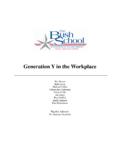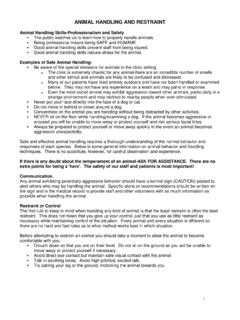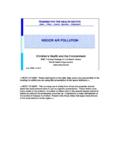Transcription of Society at a Glance 2016 - OECD
1 Society at a Glance 2016 OECD 2016 More via Society at a Glance 2016 A Spotlight on Youth Embargo 5th October 2016 The 2016 edition of Society at a Glance examines social well-being and its trends across the OECD. The number of young people not in employment, education or training (NEETs) remains elevated in many countries since the crisis; the report therefore focusses on this group of young people examining the characteristics of those at risk of being NEET along with policies to help meet the challenge. This edition also includes many new youth-specific indicators on family formation, self-sufficiency, income and poverty, health and social cohesion. The labour market situation of young people in Australia developed little favourably over the last years Youth employment rates by country, 2005-2015 NEET rates by activity status, Australia and OECD, 2005-2015 Percentage of 15-29 who not in employment, education or training [Figure ] [Figure ] THE NEET SITUATION The labour market situation of young people in Australia is favourable by international standards, but has developed quite poorly since 2008.
2 While Australia was hit much less heavily by the Great Recession than most other OECD countries, labour market outcomes for young people have not improved since. Among 15-29-year-olds, were working in 2015 the fourth-highest rate across OECD countries but percentage points less than at the start of the crisis in 2008 (see Figure above, left panel). One-third of all employed young people work part-time, typically combining studies and work. A significant number of young people are out of education and work. The NEET rate the share of young people who are Not in Employment, Education or Training attained in 2015. This is below the OECD average of , but considerably higher than the rates attained by the best-performing countries including the Netherlands ( ), Switzerland ( ) and Germany ( ).
3 In total, 580 000 15-29-year-olds were NEET in 2015, about 100 000 more than in 2008, causing an estimated earnings loss of around 1% of Australian GDP. The majority of NEETs in Australia are not looking for work: unemployed young people only accounted for one-third of all NEETs in 2015 the remaining two-thirds were inactive (Figure above, right panel). Inactive young people face in many cases additional barriers for returning to education or entering work, but they are typically much more difficult to reach out to by public services than the unemployment. Low educational attainment is the principal risk factor for being NEET. Among 25-29-year-olds, NEET rates for those with at-most lower-secondary education are three times higher than for university graduates (37% vs 11%, see Figure ]. Around 40% of all NEETs in Australia have not attained an upper-secondary qualification.)
4 Young people with poor numeracy or literacy skills are twice as likely to be NEET as those with medium skills (Figure ). Australia has, however, managed to substantially reduce early school leaving over the last decade. The share of 25-34-year-olds without an upper-secondary degree fell from 20 to 12% between 2005 and 2014. This is less than the OECD average of 16%, 4550556065707520052006200720082009201020 112012201320142015 AustraliaNew ZealandUnited KingdomOECD02468101214161820052006200720 082009201020112012201320142015 Unemployed NEETI nactive NEETOECDMore via Society at a Glance 2016 OECD 2016 though it is still higher than the rates observed in Korea (2%), Canada (8%) or the United States (9%) (Figure ). Upper-secondary completion rates are much lower, however, for disadvantaged youth including young people from low socio-economic backgrounds, those living in remote areas, and Indigenous youth.
5 There is a substantial gender gap in Australian NEET rates young women are 50% more likely to be NEET than young men. This reflects primarily the very high NEET rates for women with young children, who make up nearly half of all female NEETs. Many of them report that they would prefer to work but cannot because of a lack of affordable childcare or insufficiently flexible worktime arrangements. Indigenous young people face a much higher risk of being NEET representing 3% of the total youth population but 10% of all NEETs. The situation is particularly difficult for those living in remote and very remote areas, who face NEET rates of 45 to 55% twice the 28%-rate observed in major cities. These very high NEET rates reflect scarce labour markets opportunities in remote areas. They however result also from the fact that many of the more educated young people move to the cities.
6 For non-Indigenous youth, NEET rates do not meaningfully differ between major cities, regional and remote areas. OVERVIEW OF OTHER SOCIAL INDICATORS Unemployment is low but is higher for youth During the, crisis the working-age unemployment rate rose from in 2007, peaking at before falling back to in 2016 . These increases are small relative to the impact of the Great Recession on most OECD countries. The current unemployment rate in Australia ( ) is below the OECD average of [Figure ]. However, youth unemployment remains nearly three times higher than that of the over 25s. Incomes and poverty Incomes are well ahead of the OECD average giving Australia the 4th highest median income in the OECD [Figure ]. Australia saw a small rise of in median incomes between 2007 and 2013 while in most OECD countries incomes stagnated or fell [Figure ].
7 Poverty rates are slightly higher than average, however 13% of the population are below the poverty line compared to 11% across the OECD [Figure ]. Benefits are relatively effective at lifting people out of poverty 53% of 16-29 year olds and 58% of 30-64 year olds are lifted above the poverty line after receiving public transfers, better than the OECD averages of 41% and 49% respectively but behind best performers such as Germany and Ireland [Figure ]. Trust in others and confidence in government is above average Levels of trust in others in Australia are higher than the OECD average with 51% of the population reporting having trust in others compared to 36% across the OECD [Figure ]. 51% of adults report having confidence in the national government, higher than the 44% OECD average [Figure ].
8 Political disinterest is higher amongst young people with 28% of youth and 17% of the total population report having no interest in politics [Figure ] in line with OECD averages. Engagement in civil Society is favourable with over a third of the population volunteering compared to around one quarter across the OECD [Figure ]. Life expectancy is high and health levels are good Life expectancy at years is two years ahead of the OECD average, up substantially from in 1970 [Figure ]. Self-reported health status is one of the highest across the OECD with 85% of Australian adults reporting themselves to be in good health compared to 69% across the OECD [Figure ]. This ranges from 83% for the poorest fifth of the population to 93% for the richest fifth, one of the smaller gaps across the OECD [Figure ]. Life satisfaction rates in Australia are also higher than average [Figure ].
9 Smoking rates are relatively low, 13% of adults report smoking daily compared to nearly 20% across the OECD [Figure ] while alcohol consumption rates are slightly higher than the average [Figure ]. Contact: OECD Social Policy Division, Directorate for Employment, Labour and Social Affairs St phane Carcillo +33 (0)1 45 24 80 31















